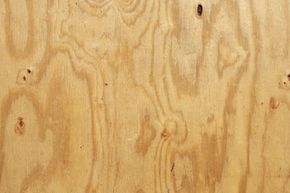Plywood is a building product that is common in the United States. It's used in everything from furniture to house construction. The big advantages of plywood include:
- Standard size (4 feet x 8 feet is the common size in the U.S.)
- Low cost for the size
- Strength
- Stability (warping and shrinkage is much less of a problem)
If plywood did not exist, you would end up making the same size piece of wood from a collection of flat boards. That approach would be a lot more expensive and not nearly as strong or stable.
Advertisement
To make plywood:
- A log is softened with steam and then mounted on a lathe.
- A long knife peels off a thin layer of wood in a continuous veneer sheet. Once dried, a thin veneer sheet like this is very strong in one direction (along the grain) and very weak in the other (across the grain).
- Several layers of veneer (generally five or seven) are layered together with the grain direction alternating between the different layers. Glue is used between the layers.
- The stack is heated and pressed to form a rigid panel.
Because the grain direction of the layers of veneer alternate, the panel is extremely strong in all directions.
In oriented strand board, much less-expensive chips of wood are used instead of a continuous veneer. These chips are thin and fairly large, and during manufacture they are lined up in the different layers (oriented) so that the panel is strong in all directions. OSB is about half the cost of plywood, but less attractive.
Advertisement
